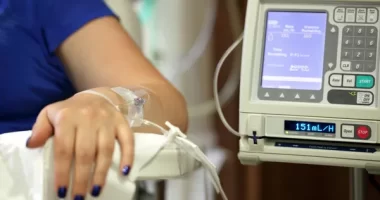Cervical cancer kills thousands of women each year, especially in low-income countries. HIV-positive women are at significantly higher risk, making effective screening crucial.
Finding the best approach to cervical cancer screening for HIV-positive women requires a nuanced and tailored strategy. While the goal is consistent – early detection and prevention – the path to achieving it can vary depending on several factors. Here’s an overview of the key considerations according to the study, published in Nature Medicine, which evaluated various screening strategies for Tanzanian women living with HIV, supporting the World Health Organization’s (WHO) 2021 guidelines for reducing cervical cancer deaths in this high-risk group.:
Effectiveness:
- Primary HPV testing: Emerging as the most effective approach, this test directly detects the presence of high-risk HPV strains, the main cause of cervical cancer. Studies, like the Tanzanian one you mentioned, highlight its potential to significantly reduce cancer incidence in HIV-positive women.
- Triage methods: Once HPV-positive, further testing can be targeted using triage methods like HPV genotyping, cytology, or VIA. These tests help identify women who need immediate treatment or further investigation.
- Other methods: Traditional methods like cytology and VIA remain relevant in specific settings, especially where resources for HPV testing might be limited.
Context matters:
- Local resources and infrastructure: The availability of healthcare facilities, trained personnel, and diagnostic tools significantly impact the feasibility of different approaches.
- Cultural preferences and accessibility: Understanding local attitudes towards cancer screening and ensuring accessibility for women from diverse backgrounds is crucial for successful implementation.
- Integration with existing HIV care: Ideally, cervical cancer screening should be seamlessly integrated into existing HIV care programs for better adherence and continuity.
Read on the learn everything about the study.
The Problem

- Cervical cancer mortality in low- and middle-income countries is alarmingly high, with Eastern Africa facing a particularly heavy burden.
- HIV-positive women are six times more likely to develop cervical cancer.
- WHO’s “90-70-90” targets by 2030 aim to prevent millions of cases and deaths through vaccination, screening, and treatment.
- Optimizing screening strategies for HIV-positive women is crucial due to their higher risk and variations in test effectiveness across HIV stages.
MORE NEWS: Can Breast Cancer Survivors Over 50 Reduce Frequent Mammograms?
The Study
- Researchers employed a simulation model incorporating sexual behavior, HIV/HPV infection dynamics, and demographic data.
- They focused on Tanzanian women born in 2005 and acquired HIV before age 25, analyzing various screening approaches:
- Primary visual inspection with acetic acid (VIA)
- Primary cytology
- Primary HPV screening
- Both strategies with and without triage (HPV 16/18 genotyping, colposcopy, cytology, VIA) were considered.
- The main hypothesis assumed 70% participation in routine screenings and 90% in follow-up appointments.
- Primary endpoints were cancer incidence and mortality reduction, number needed to treat (NNT), and pre-cancer treatment-related preterm deliveries.
Results
- Without any screening, the simulated lifetime cervical cancer incidence and mortality rates were alarmingly high.
- Primary HPV testing every 3 years without triage for women aged 25-50 showed the most significant impact, reducing cancer incidence by 64%.
- HPV-positive women prioritized for treatment further reduced cancer incidence (57-62%), depending on the triage method.
- Primary cytology and VIA every 3 years were also effective, reducing cancer incidence by 55% and 51%, respectively.
- Five-year HPV screening intervals were slightly less effective than three-year intervals, with or without triaging.
- Benefits and harms were balanced: Primary HPV screening every 3 years without triage resulted in 116,298 pre-cancer treatments and 426 additional preterm deliveries (NNT: 38.7).
- Different triage methods with HPV testing yielded varying NNTs and pre-cancer treatments.
Implications
- This study supports the WHO’s recommendation of primary HPV testing for HIV-positive women, with triage for additional tests based on HPV type or other factors.
- The findings highlight the importance of tailoring screening strategies to specific contexts, considering factors like HIV status, resource availability, and potential harms.
- Implementing effective cervical cancer screening programs for HIV-positive women is crucial for reducing their mortality and achieving the WHO’s global goals.
- Primary HPV testing every 3 years without triage appears most effective, but triage strategies can further refine targeting and reduce unnecessary interventions.
READ MORE NEWS: Anti-Obesity Drugs May Offer New Hope for Preventing Kidney Disease
Beyond Tanzania

- The study’s implications extend beyond Tanzania’s borders. Its findings can inform cervical cancer prevention strategies in other low- and middle-income countries with high HIV prevalence. By sharing valuable insights on optimizing screening and triage, the study contributes to a global effort to reduce cervical cancer deaths among HIV-positive women.
Looking Ahead
- This study paves the way for further research. It raises questions about the long-term impact of different screening strategies, the optimal timing of follow-up visits, and the integration of cervical cancer screening into existing HIV care programs. Addressing these questions will further refine our approach to effectively prevent and treat cervical cancer in HIV-positive women.
In conclusion, this Tanzanian study goes beyond presenting statistics and delves deeper into the complexities of optimizing cervical cancer screening for HIV-positive women. By emphasizing context-specific solutions, exploring the nuances of triage, and advocating for flexibility within international guidelines, the study offers valuable insights for improving cancer prevention and ultimately saving lives. Study source









